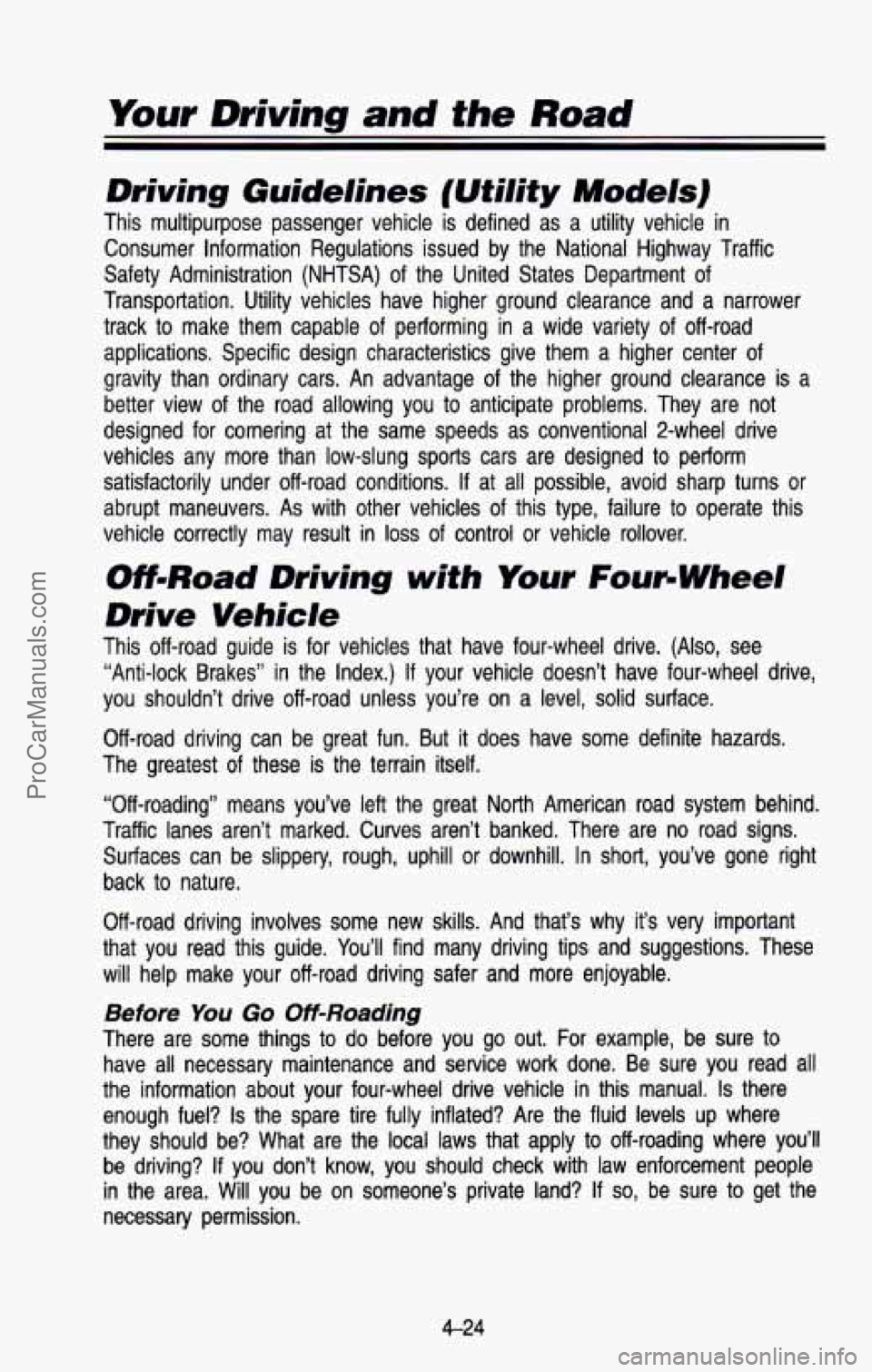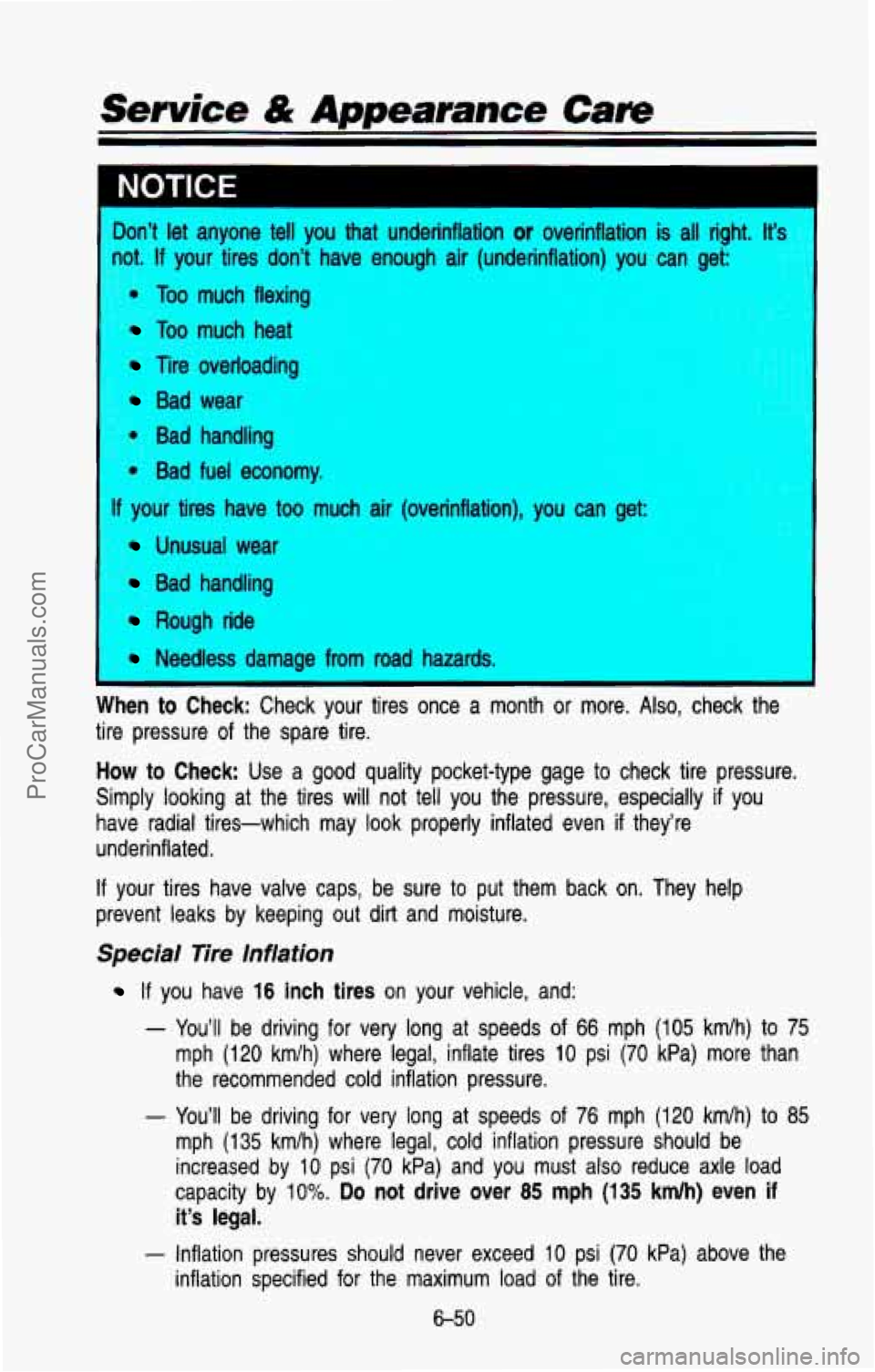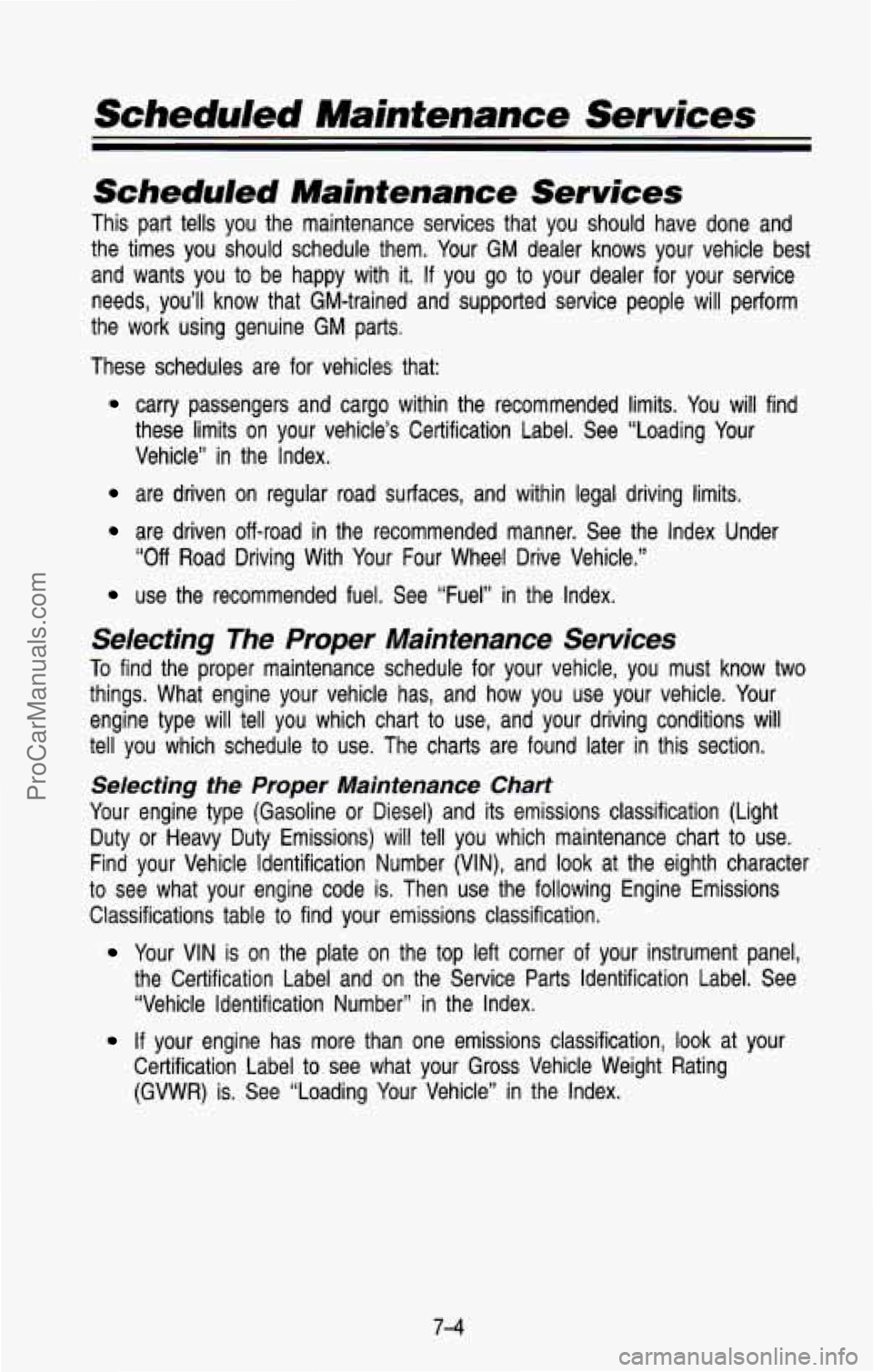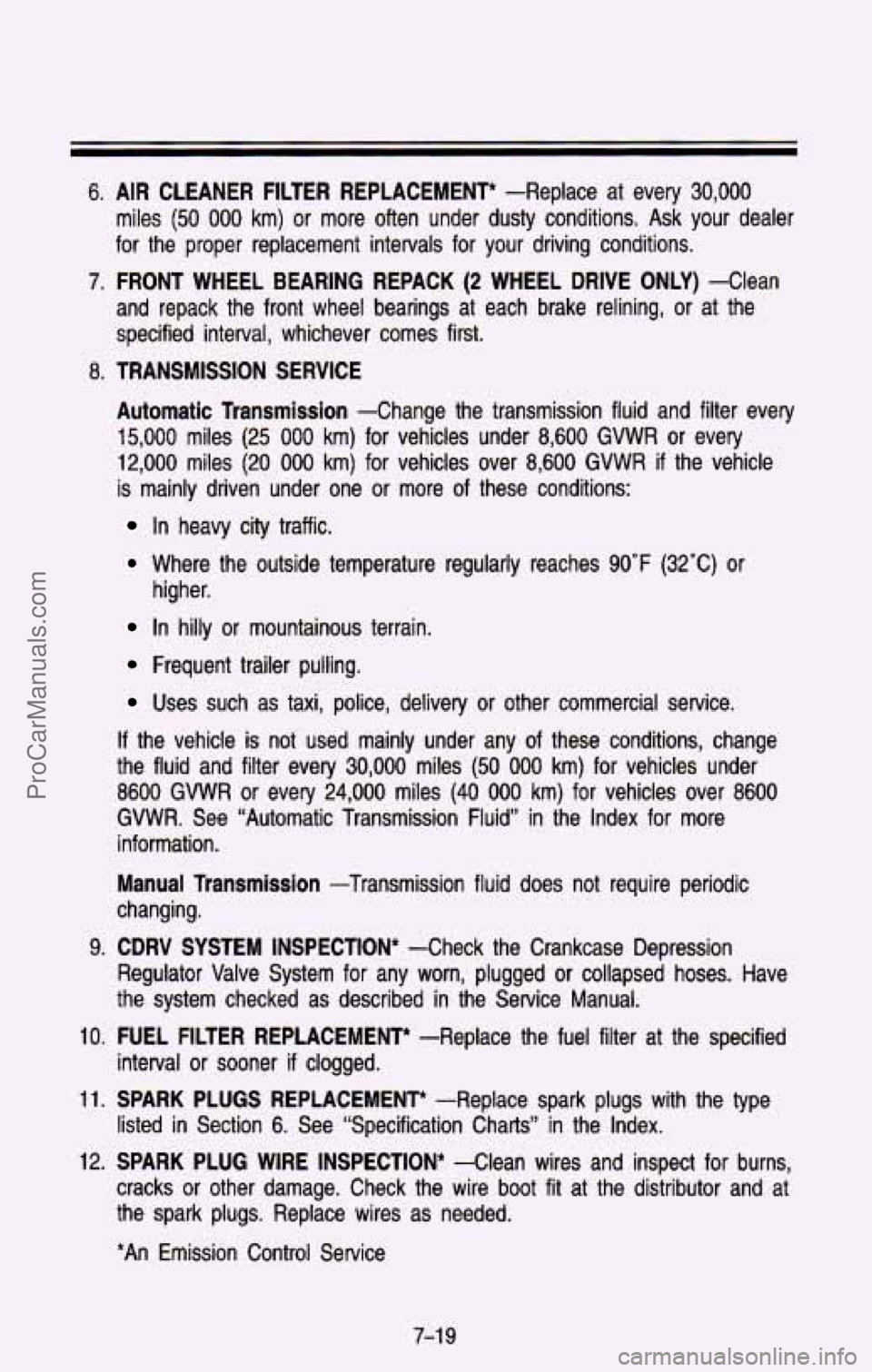1993 CHEVROLET SUBURBAN fuel type
[x] Cancel search: fuel typePage 191 of 386

Driving Guidelines (Utility Models)
This multipurpose passenger vehicle is defined as a utility vehicle in
Consumer Information Regulations issued by the National Highway \
Traffic
Safety Administration (NHTSA) of the United States Department of
Transportation. Utility vehicles have higher ground clearance and\
a narrower
track to make them capable
of performing in a wide variety of off-road
applications. Specific design characteristics give them a higher center of
gravity than ordinary cars. An advantage of the higher ground clearance is a
better view
of the road allowing you to anticipate problems. They are not
designed for cornering at the same speeds as conventional 2-whe\
el drive
vehicles any more than low-slung sports cars are designed to p\
erform
satisfactorily under off-road conditions. If at
all possible, avoid sharp turns or
abrupt maneuvers.
As with other vehicles of this type, failure to operate this
vehicle correctly may result in
loss of control or vehicle rollover.
OffmRoad Driving with Your Four-Wheel
Drive Vehicle
This off-road guide is for vehicles that have four-wheel drive. (Also, see
“Anti-lock Brakes” in the Index.)
If your vehicle doesn’t have four-wheel drive,
you shouldn’t drive off-road unless you’re on
a level, solid surface.
Off-road driving can be great fun. But it does have some definite hazards.
The greatest of these is the terrain itself.
“Off-roading” means you’ve left the great North American road system behind.
Traffic lanes aren’t marked. Curves aren’t banked. There a\
re no road signs.
Surfaces can be slippery, rough, uphill
or downhill. In short, you’ve gone right
back to nature.
Off-road driving involves some new skills. And that’s why it’s very important
that you read this guide. You’ll find many driving tips and suggestions. These
will help make your off-road driving safer and more enjoyable.
Before You Go Off-Roading
There are some things to do before you go out. For example, be sure to
have all necessary maintenance and service work done. Be sure you read \
all
the information about your four-wheel drive vehicle in this manual.
Is there
enough fuel?
Is the spare tire fully inflated? Are the fluid levels up where
they should be? What are the local laws that apply to off-roading where you’ll
be driving?
If you don’t know, you should check with law enforcement people
in the area. Will you be on someone’s private land?
If so, be sure to get the
necessary permission.
4-24
ProCarManuals.com
Page 315 of 386

Don’t let anyone tell you that underinflation or overinflation is all right. It’-
9. If your tires don’t have enough air (underinflation) you can get
Too much flexing
Too much heat
tire overloading
Bad wear
Bad handling
Bad fuel economy.
I If your tires have too much air (overinflation), you can get:
Unusual wear
Bad handling
Rough ride
Needless damage from road hazards.
nth
or more. Also, check the
tire pressure of the spare tire.
How to Check: Use a good quality pocket-type gage to check tire pressure.
Simply looking at the tires will not tell you the pressure, e\
specially if you
have radial tires-which may look properly inflated even
if they’re
underinflated.
If your tires have valve caps, be sure to put them back on. The\
y help
prevent leaks by keeping out dirt and moisture.
Special Tire Inflation
If you have 16 inch tires on your vehicle, and:
- You’ll be driving for very long at speeds of 66 mph (105 km/h) to 75
mph
(120 km/h) where legal, inflate tires 10 psi (70 kPa) more than
the recommended
cold inflation pressure,
- You’ll be driving for very long at speeds of 76 mph (120 kmih) to 85
mph (135 km/h) where legal, cold inflation pressure should be
increased
by 10 psi (70 kPa) and you must also reduce axle load
capacity by
10%. Do not drive over 85 mph (135 kmlh) even if
it’s legal.
- Inflation pressures should never exceed 10 psi (70 kPa) above the
inflation specified for the maximum
load of the tire.
6-50
ProCarManuals.com
Page 333 of 386

Service & Appearance Care
Specification Charts
Replacement Parts
Replacement part numbers listed in this section are based on the latest
information available at the time
of printing, and are subject to change. If a
part listed in this manual is not the same as the part used in your vehicle
when
it was built, or if you have any questions, please contact your GM truck
dealer.
Engine identification
Liter VIN Fuel Produced
Displacement Type Engine Code System BY Emissions
5.7 V8 K TB I U.S., Can.
7.4 V8 N TB I us.
*
*
*Light Duty Emissions with 8500 GVWR and below or:
Heavy Duty Emissions with 8501 GVWR and
above.
TO291
Wheel Nut Torque
MODEL DESCRIPTION TORQUE
C 1500 5 bolts (14mm) 120 ft. Ibs. (1 60 Nmm)
K 1500, C-K 2500 6 bolts (1 4mm) 120 ft. Ibs. (160
N-m)
C-K 2500 8 bolts (14mm) 120 ft. Ibs. (160 Nem)
I TO2951
Cooling System Capacity
VIN QUANTITY*
ENGINE CODE Without NC With AIC
5.7L K 17.5 Quarts (16.5 Liters)
18 Quarts (1 7 Liters)
7.4- N 23 Quarts
(22 Liters) 25 Quarts (23.5 Liters)
*All quantities are approximate.
*After refill, the level
MUST be checked as outlined under “Engine Cooling
System” in Section
5.
TO292
6-68
ProCarManuals.com
Page 334 of 386

Crankcase Capacify
QUANTITY*
ENGINE VIN CODE Without Filter With Filter
5.7L K 4 Quarts (3.8 Liters) 5 Quarts (4.8 Liters)
7.4L N 6 Quarts (5.7 Liters) 7 Quarts (6.6 Liters)
*All quantities are approximate.
*After refill, the level MUST be checked as outlined under “\
Engine Oil
TO296
And Filter Recommendations” in Section
5.
Air Condifioning Refrigeranf Capacify
TYPE* QUANTITY
Refrigerant R-12 Front
AJC 3.0 Ibs. (1.360 kg)
Front and Rear AJC 4.25 Ibs. (1.927 kg)
*Not all air conditioning refrigerants are the same.
If the air conditioning
system in your vehicle needs refrigerant, be sure the proper r\
efrigerant is
used. If you’re not sure, ask your GM dealer. TO302
Fuel Tank Capacify
I -1
Utility Model-Standard 30 Gallons (113 Liters)
Wagon Model-Standard 42 Gallons (159 Liters)
All quantities are for a completely dry tank and are approxima\
te. TO2971
Service Replacemenf Part and Filfer Recommendations
5.7 (K)
6.2 (C)
6.2
(J)*
6.5 (F)*
-
Oil
Filter
PF5 1
PF35t PF35t
PF35
PF35
PF35
PF35
-
1
Air PCV
Cleaner Valve
A348C
cv774c
A348C cv774c
A644C
A644C
A91 7C
A348C cv774c
AI 7acw cv7agc
Spark**
Plugs
.CR43TS
.CR43TS
.CR43TS
-
.CR43TS i
use a PF51 oil filter
*Heavy Duty Emission Engine
**Use
AC copper-cored resistor type spark plugs.
Fuel
Filter
GF481
GF481
GF481
TP
1 006
TP 1 006
TP 1 006 G F48 1
Radiator
RC36
RC36
RC36
RC32
RC32
RC32
RC36
Cap
6-69
ProCarManuals.com
Page 341 of 386

Scheduled Maintenance Services
Scheduled Maintenance Services
This part tells you the maintenance services that you should h\
ave done and
the times you should schedule them. Your
GM dealer knows your vehicle best
and wants you to be happy with it.
If you go to your dealer for your service
needs, you’ll know that GM-trained and supported service peop\
le will perform
the work using genuine GM parts.
These schedules are for vehicles that:
carry passengers and cargo within the recommended limits. You will find
these limits on your vehicle’s Certification Label. See “L\
oading Your
Vehicle” in the Index.
are driven on regular road surfaces, and within legal driving \
limits.
are driven off-road in the recommended manner. See the index Under
use the recommended fuel. See “Fuel” in the Index.
“Off Road Driving With Your Four Wheel Drive Vehicle.”
Selecting The Proper Maintenance Services
To find the proper maintenance schedule for your vehicle, you must know\
two
things. What engine your vehicle has, and how you use your ve\
hicle. Your
engine type will tell you which chart to use, and your driving conditions will
tell you which schedule to use. The charts are found later in this section.
Selecting the Proper Maintenance Chart
Your engine type (Gasoline or Diesel) and its emissions classification (L\
ight
Duty
or Heavy Duty Emissions) will tell you which maintenance chart to use.
Find your Vehicle Identification Number (VIN), and
look at the eighth character
to see what your engine code is. Then use the following Engine Emissions
Classifications table
to find your emissions classification.
Your VIN is on the plate on the top left corner of your instrument panel,
the Certification Label and on the Service Parts Identification Label. See
“Vehicle Identification Number” in the Index.
Certification Label to see what your Gross Vehicle Weight Rating
(GVWR) is. See “Loading Your Vehicle” in the Index.
If your engine has more than one emissions classification, look at your
7-4
ProCarManuals.com
Page 356 of 386

6. AIR CLEANER FILTER REPLACEMENT* -Replace at every 30,000
miles (50 000 km) or more often under dusty conditions. Ask your dealer
for the proper replacement intervals for your driving conditions\
.
7. FRONT WHEEL BEARING REPACK (2 WHEEL DRIVE ONLY) -Clean
and repack the front wheel bearings at each brake relining,
or at the
specified interval, whichever comes first.
8.
TRANSMISSION SERVICE
Automatic Transmission
-Change the transmission fluid and filter every
15,000 miles (25 000 km) for vehicles under 8,600 GVWR or every
12,000 miles
(20 000 km) for vehicles over 8,600 GVWR if the vehicle
is mainly driven under one
or more of these conditions:
In heavy city traffic.
Where the outside temperature regularly reaches 90°F (32°C) or
In hilly or mountainous terrain.
higher.
Frequent trailer pulling.
Uses such as taxi, police, delivery or other commercial service.
If the vehicle is not used mainly under any of these conditions, change
the fluid and filter every
30,000 miles (50 000 km) for vehicles under
8600 GVWR or every
24,000 miles (40 000 km) for vehicles over 8600
GVWR. See “Automatic Transmission Fluid” in the Index for more
information.
Manual Transmission -Transmission fluid does not require periodic
changing.
9. CDRV SYSTEM INSPECTION* -Check the Crankcase Depression
Regulator Valve System
for any worn, plugged or collapsed hoses. Have
the system checked as described in the Service Manual.
10. FUEL FILTER REPLACEMENT --Replace the fuel filter at the specified
interval
or sooner if clogged.
11.
SPARK PLUGS REPLACEMENT” --Replace spark plugs with the type
listed in Section
6. See “Specification Charts” in the Index.
12.
SPARK PLUG WIRE INSPECTION* -Clean wires and inspect for burns,
cracks
or other damage. Check the wire boot fit at the distributor and at
the spark plugs. Replace wires as needed.
*An Emission Control Service
7-1 9
ProCarManuals.com